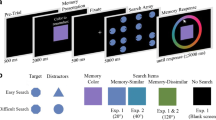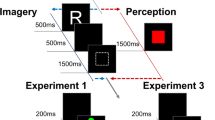Abstract
Being confronted with the depiction of a familiar object activates a number of properties of the object that are stored in memory. Memory properties such as color and size have been shown to interfere with the processing of the color and of the size of the depiction, so that that reaction times are longer when the color or size of the depiction are incongruent with the stored knowledge about the object. In the case of color, it is known that the memorized information also affects the appearance of the depiction, for example when a gray banana appears slightly yellow, a phenomenon known as memory color effect. Here, I tested whether a memory size effect also occurs. To this aim, I conducted one experiment where observers matched either the screen size or the real-world size of pairs of animals or vehicles. The results indicate that the screen matches are biased in the same direction as the real-world size matches, opposite of what would be predicted by a memory color effect. This result was replicated in a second experiment using a different and larger set of animal images. Overall, I confirm that observers cannot ignore the real-world size information when they attempt to match the screen size of two items, although this results in a bias towards the canonical size of the items, rather than in a memory size effect.












Similar content being viewed by others
References
Baird, J. C. (1963). Retinal and assumed size cues as determinants of size and distance perception. Journal of Experimental Psychology, 66(2), 155–162. https://doi.org/10.1037/h0046554.
Baird, J. C. (1965). Stimulus and response factors in size instruction effects. Perceptual and Motor Skills, 21(3), 915–924. https://doi.org/10.2466/pms.1965.21.3.915.
Bannert, M. M., & Bartels, A. (2013). Decoding the yellow of a gray banana. Current Biology, 23(22), 2268–2272. https://doi.org/10.1016/j.cub.2013.09.016.
Collegio, A. J., Nah, J. C., Scotti, P. S., & Shomstein, S. (2019). Attention scales according to inferred real-world object size. Nature Human Behaviour, 3(1), 40–47. https://doi.org/10.1038/s41562-018-0485-2.
Coutanche, M. N., & Koch, G. E. (2018). Creatures great and small: Real-world size of animals predicts visual cortex representations beyond taxonomic category. NeuroImage, 183, 627–634. https://doi.org/10.1016/j.neuroimage.2018.08.066.
Coutanche, M. N., & Thompson-Schill, S. L. (2019). Neural activity in human visual cortex is transformed by learning real world size. NeuroImage, 186, 570–576. https://doi.org/10.1016/j.neuroimage.2018.11.039.
Epstein, W. (1963). The influence of assumed size on apparent distance. The American Journal of Psychology, 76(2), 257–265. https://doi.org/10.2307/1419162.
Fisher, C., & Sperandio, I. (2018). Familiar size effects on reaction time: When congruent is better. Journal of Experimental Psychology Human Perception and Performance, 44(9), 1414–1425. https://doi.org/10.1037/xhp0000543.
Gibson, J. J. (1950). The perception of the visual world. Oxford: Houghton Mifflin.
Gilinsky, A. (1955). The effect of attitude upon the perception of size. American Journal of Psychology, 68(2), 173.
Gliksman, Y., Itamar, S., Leibovich, T., Melman, Y., & Henik, A. (2016). Automaticity of conceptual magnitude. Scientific Reports, 6, 21446.
Hansen, T., Olkkonen, M., Walter, S., & Gegenfurtner, K. R. (2006). Memory modulates color appearance. Nature Neuroscience, 9(11), 1367–1368. https://doi.org/10.1038/nn1794.
Higashiyama, A. (1984). The effects of familiar size on judgments of size and distance: An interaction of viewing attitude with spatial cues. Perception and Psychophysics, 35(4), 305–312. https://doi.org/10.3758/BF03206333.
Kleiner, M., Brainard, D., Pelli, D., Ingling, A., Murray, R., Broussard, C., et al. (2007). What’s new in Psychtoolbox-3. Perception, 36(14), 1.
Konkle, T., & Caramazza, A. (2013). Tripartite organization of the ventral stream by animacy and object size. The Journal of Neuroscience, 33(25), 10235. https://doi.org/10.1523/JNEUROSCI.0983-13.2013.
Konkle, T., & Oliva, A. (2011). Canonical visual size for real-world objects. Journal of Experimental Psychology Human Perception and Performance, 37(1), 23–37. https://doi.org/10.1037/a0020413.
Konkle, T., & Oliva, A. (2012). A familiar-size Stroop effect: Real-world size is an automatic property of object representation. Journal of Experimental Psychology Human Perception and Performance, 38(3), 561.
Lafer-Sousa, R., Hermann, K. L., & Conway, B. R. (2015). Striking individual differences in color perception uncovered by ‘the dress’ photograph. Current Biology, 25(13), R545–R546. https://doi.org/10.1016/j.cub.2015.04.053.
Linsen, S., Leyssen, M. H. R., Sammartino, J., & Palmer, S. E. (2011). Aesthetic preferences in the size of images of real-world objects. Perception, 40(3), 291–298. https://doi.org/10.1068/p6835.
Long, B., & Konkle, T. (2017). A familiar-size Stroop effect in the absence of basic-level recognition. Cognition, 168, 234–242. https://doi.org/10.1016/j.cognition.2017.06.025.
Long, B., Konkle, T., Cohen, M. A., & Alvarez, G. A. (2016). Mid-level perceptual features distinguish objects of different real-world sizes. Journal of Experimental Psychology General, 145(1), 95–109. https://doi.org/10.1037/xge0000130.
Murray, S. O., Boyaci, H., & Kersten, D. (2006). The representation of perceived angular size in human primary visual cortex. Nature Neuroscience, 9(3), 429–434. https://doi.org/10.1038/nn1641.
Naor-Raz, G., Tarr, M. J., & Kersten, D. (2003). Is color an intrinsic property of object representation? Perception, 32(6), 667–680. https://doi.org/10.1068/p5050.
Nasr, S., Echavarria, C. E., & Tootell, R. B. H. (2014). Thinking outside the box: rectilinear shapes selectively activate scene-selective cortex. The Journal of Neuroscience, 34(20), 6721. https://doi.org/10.1523/JNEUROSCI.4802-13.2014.
Olkkonen, M., Hansen, T., & Gegenfurtner, K. R. (2008). Color appearance of familiar objects: Effects of object shape, texture, and illumination changes. Journal of Vision, 8(5), 13. https://doi.org/10.1167/8.5.13.
Paivio, A. (1975). Perceptual comparisons through the mind’s eye. Memory and Cognition, 3(6), 635–647. https://doi.org/10.3758/BF03198229.
Pelton, L., & Solley, C. (1968). Acceleration of reversals of a Necker cube. The American Journal of Psychology, 81(4), 585–588. https://doi.org/10.2307/1421064.
Reynvoet, B., Vos, H., & Henik, A. (2018). Comparative judgment of familiar objects is modulated by their size. Experimental Psychology, 65(6), 353–359. https://doi.org/10.1027/1618-3169/a000418.
Rubinsten, O., & Henik, A. (2002). Is an ant larger than a lion? Acta Psychologica, 111(1), 141–154. https://doi.org/10.1016/S0001-6918(02)00047-1.
Schifferstein, H. N. J., Wehrle, T., & Carbon, C.-C. (2019). Consumer expectations for vegetables with typical and atypical colors: The case of carrots. Food Quality and Preference, 72, 98–108. https://doi.org/10.1016/j.foodqual.2018.10.002.
Scholte, H. S., Meuwese, J. D. I., Lamme, V. A. F., Vandenbroucke, A. R. E., & Fahrenfort, J. J. (2014). Prior knowledge about objects determines neural color representation in human visual cortex. Cerebral Cortex, 26(4), 1401–1408. https://doi.org/10.1093/cercor/bhu224.
Shen, M., Xie, J., Liu, W., Lin, W., Chen, Z., Marmolejo-Ramos, F., & Wang, R. (2016). Interplay between the object and its symbol: The size-congruency effect. Advances in Cognitive Psychology, 12(2), 115–129. https://doi.org/10.5709/acp-0191-7.
Siple, P., & Springer, R. M. (1983). Memory and preference for the colors of objects. Perception and Psychophysics, 34(4), 363–370. https://doi.org/10.3758/BF03203049.
Smith, W. M. (1952). Past experience and the perception of visual size. The American Journal of Psychology, 65(3), 389–403.
Tyer, Z. E., Allen, J. A., & Pasnak, R. (1983). Instruction effects on size and distance judgments. Perception and Psychophysics, 34(2), 135–139. https://doi.org/10.3758/BF03211338.
van Ee, R., van Dam, L. C. J., & Brouwer, G. J. (2005). Voluntary control and the dynamics of perceptual bi-stability. Vision Research, 45(1), 41–55. https://doi.org/10.1016/j.visres.2004.07.030.
Warren, J. M., & Pinneau, S. R. (1955). Influence of form on judgment of apparent area. Perceptual and Motor Skills, 5(1), 7–10. https://doi.org/10.2466/pms.1955.5.g.7.
Witzel, C., & Gegenfurtner, K. R. (2018). Color perception: Objects, constancy, and categories. Annual Review of Vision Science, 4(1), 475–499. https://doi.org/10.1146/annurev-vision-091517-034231.
Witzel, C., Olkkonen, M., & Gegenfurtner, K. R. (2016). Memory colours affect colour appearance. Behavioral and Brain Sciences, 39, e262. https://doi.org/10.1017/S0140525X15002587.
Witzel, C., Racey, C., & O’Regan, J. K. (2017). The most reasonable explanation of “the dress”: Implicit assumptions about illumination. Journal of Vision, 17(2), 1. https://doi.org/10.1167/17.2.1.
Acknowledgements
Matteo Valsecchi is supported by the SFB TRR 135/Project A8 Grant from the Deutsche Forschungsgemeinschaft. I would like to thank Theresa Geier and Benita Nmakwe for help with data collection and stimulus construction, Cesar Echavarria and Shahin Nasr for providing the rectilinearity toolbox and Christoph Witzel for his comments and suggestions during the preparation of the manuscript. The dataset pertaining to this study is available at zenodo.org (https://doi.org/10.5281/zenodo.3402735).
Author information
Authors and Affiliations
Corresponding author
Ethics declarations
Conflict of interest
The author declares that he has no conflict of interest.
Ethical standards
All the procedures performed were in accordance with the ethical standards of the institutional research committee (the study protocol was approved by the local ethics committee at the University of Giessen, approval number: LEK FB6 2017-08) and with the 1964 Helsinki Declaration and its later amendments or comparable ethical standards.
Informed consent
Informed consent was obtained from all individual participants included in the study.
Additional information
Publisher's Note
Springer Nature remains neutral with regard to jurisdictional claims in published maps and institutional affiliations.
Rights and permissions
About this article
Cite this article
Valsecchi, M. Screen size matches of familiar images are biased by canonical size, rather than showing a memory size effect. Psychological Research 85, 246–258 (2021). https://doi.org/10.1007/s00426-019-01247-6
Received:
Accepted:
Published:
Issue Date:
DOI: https://doi.org/10.1007/s00426-019-01247-6




